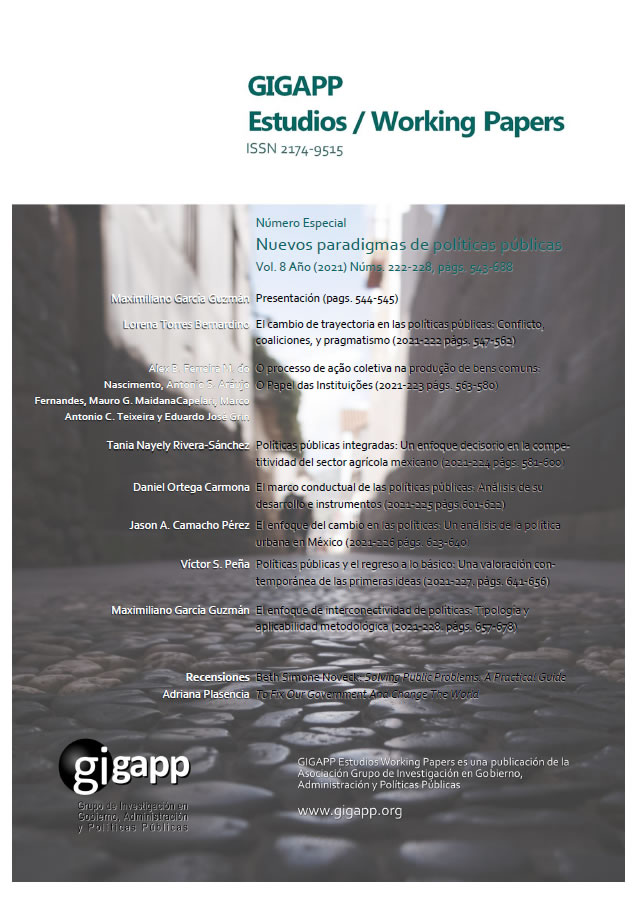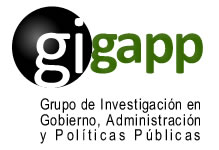Políticas públicas integradas
Un enfoque decisorio en la competitividad del sector agrícola mexicano
Resumen
En los últimos años el Enfoque de Integración en política pública se ha convertido en una herramienta inherente en la gestión de un problema multicausal. Motivo de ello es la complejidad y multidimensionalidad que atañen a los problemas públicos actuales, los cuales rebasan el tratamiento tradicional del ciclo en políticas públicas. Una de las políticas más reveladoras que exige esta atención en su especificidad y en conjunto con otros espacios de políticas es la política agrícola. Esta política es parte de un trabajo sistemático por excelencia conducido por diversos espacios de políticas pertenecientes a una mayor. Actualmente, su diseño ha limitado la intervención integral e integrada en la competitividad de las productoras y productores en México. Como consecuencia se ha continuado con una política superficial que promueve la exclusión de agricultores, fragmentación de procesos agroalimentarios y ausencia de complementariedad en los instrumentos que promueve. Por lo comentado, el objetivo del siguiente documento es analizar el Enfoque de Integración en políticas públicas y su pertinencia en el diseño de la política alimentaria federal, de manera particular en la política agrícola.
Descargas
Citas
Acuña H., Carlos (2010). “Los desafíos de la coordinación y la integralidad para las Políticas y la Gestión Pública en América Latina: Una introducción”, Proyecto de Modernización del Estado, Jefatura de Gabinete de Ministros, Ciudad Autónoma de Buenos Aires, pp. 9-13.
Arellano Gault, David y Blanco, Felipe (2013). “Políticas Públicas y Democracia”, Instituto Federal Electo-ral, México, pp. 63.
Berlanga Robles, Héctor M. (2013). “Subsidios al campo en México. Los pequeños productores y la política Pública”, Documento elaborado para RIMISP, Centro de Análisis e Investigación, FUNDAR, pp 28.
Briassoulis, Helen (2004). “Policy integration for complex policy problems: What, why and how” In Paper presented at the Berlin Conference on the Human Dimensions of Global Environmental Change: Greening of Policies - Interlinkages and Policy Integration, Berlin.
Cejudo, Guillermo M. y Michel, Cynthia L. (2016). “Coherencia y políticas públicas: metas, instrumentos y poblaciones objetivo”, en Gestión y Política Pública, VolUmen XXV- número 1, pp. 3-31.
Caballero García, José Francisco (2007). “La política integral como respuesta a la multidimensionalidad de la pobreza”, Espacios Públicos, vol. 10, núm. 19, Universidad Autónoma del Estado de México Toluca, México, pp. 150-168.
Cejudo, Guillermo M y Michel, Cynthia L. (2015). “Resolviendo problemas sociales complejos mediante la integración de políticas. El caso de la Cruzada Nacional contra el Hambre en México”, Caracas, Vene-zuela, Revista del CLAD Reforma y Democracia, núm. 63, septiembre- diciembre, 2015, pp. 33- 64.
Candel, Jeroen J.L And Pereira, Laura (2016). “Towards integrated food policy: Main challenges and steps ahead Environmental Science and Policy”, 73, pp. 89-92.
Candel Jeroen J. L. And Biesbroek, Robbert (2016). “Toward a processual understanding of policy inte-gration”, Public Administration and Policy Group, Wageningen University, Hollandseweg 1, 6706 KN Wageningen, The Netherlands.
Enciso L, Angélica (2020), “Fragmentada, la política alimentaria según el balance del CONEVAL 2018-2019”, Periódico La Jornada/SOCIEDAD,Lunes 20 de enero de 2020, p. 31, https://www.jornada.com.mx/2020/01/20/sociedad/031n1soc, 17-11-2020.
Engel, Wanda (2004). Políticas integrales de reducción de la pobreza: el desafío de la efectividad efecti-vidad, Banco Interamericano de Desarrollo.
-FAO (2019). “El sistema alimentario en México, Oportunidades para el campo mexicano en la Agenda 2030 de Desarrollo Sostenible”, Ciudad de México, 68 pp., http://www.fao.org/3/CA2910ES/ca2910es.pdf, 13-01-2021.
Howlett, M., Rayner, J. (2007). “Design principles for policy mixes: cohesion and coherence in "New go-vernance arrangements". Policy Society 26, 1–18.
Leyton, C.; Cortínez, V.; Fernández, I.; Fernández, J. (2017). “Desafíos Institucionales para la Articulación de Políticas Públicas”, serie documento de trabajo N° 229. Grupo de Trabajo Inclusión Social y Desa-rrollo. Rimisp Santiago, Chile.
López, R. L (2013). Iniciativa con proyecto de decreto que adiciona el artículo 5 de la Ley de Organizacio-nes Ganaderas. Gaceta Parlamentaria, Número 3870-II, http://gaceta.diputados.gob.mx/Gaceta/62/2013/sep/20130926-II.html, 13-08-2020.
Meijers, Evert and Stead, Dominic (2004). “Policy integration: What does it mean and how can it be achie-ved? A multi-disciplinary review”, Conference on the Human Dimensions of Global Environmental Change: Greening of Policies – Interlinkages and Policy Integration, Berlin.
Philipp Trein, Iris Meyer & Martino Maggetti (2019). “The Integration and Coordination of Public Policies: A Systematic Comparative Review”, Journal of Comparative Policy Analysis: Research and Practice, 21:4, 332-349, DOI: 10.1080/13876988.2018.1496667.
Repetto, Fabián y Fernández, J.P. (2012). “Coordinación de políticas, programas y proyectos sociales”. Buenos Aires: CIPPEC y UNICEF.
Scott, Jhonn (2010). “Subsidios agrícolas en México: ¿quién gana, y cuánto? En Subsidios para la desigual-dad”. Las políticas públicas del maíz en México a partir del libre comercio, coordinadores: Coordina-dores: Jonathan Fox y Libby Haight, Centro de Investigación y Docencia Económicas University of Ca-lifornia, Santa Cruz, pp. 73-127.
Underdal, A. (1980). “Integrated marine policy – What? Why? How? Marine Policy” 4(3) pp. 159-169.
Derechos de autor 2021 Tania Nayely Rivera Sánchez (Autor/a)

Esta obra está bajo licencia internacional Creative Commons Reconocimiento-NoComercial-CompartirIgual 4.0.
Aquellos autores/as que tengan publicaciones con esta revista, aceptan los términos siguientes:
a. Los autores/as conservarán sus derechos de autor y garantizarán a la revista el derecho de primera publicación de su obra, el cuál estará simultáneamente sujeto a la Licencia de reconocimiento de Creative Commons Attribution-NonCommercial-ShareAlike 4.0 International (CC BY-NC-SA 4.0) que permite a terceros compartir la obra siempre que se indique su autor y su primera publicación esta revista.
Con esta licencia de acceso abierto, los lectores (usuarios) pueden:
- Compartir — copiar y redistribuir el material en cualquier medio o formato
- Adaptar — remezclar, transformar y construir a partir del material
Bajo los siguientes términos:
-
Atribución — usarios deberán dar crédito de manera adecuada, brindar un enlace a la licencia, e indicar si se han realizado cambios. Puede hacerlo en cualquier forma razonable, pero no de forma tal que sugiera que usted o su uso tienen el apoyo de la licenciante.
-
NoComercial — usuarios no puede hacer uso del material con propósitos comerciales.
-
CompartirIgual — Si remezcla, transforma o crea a partir del material, usuarios deben distribuir su contribución bajo la misma licencia del original.
-
Sin restricciones adicionales: los usuarios no pueden aplicar términos legales o medidas tecnológicas que restrinjan legalmente a otros de hacer cualquier cosa que permita la licencia.
b. Los autores/as podrán adoptar otros acuerdos de licencia no exclusiva de distribución de la versión de la obra publicada (p. ej.: depositarla en un archivo telemático institucional o publicarla en un volumen monográfico) siempre que se indique la publicación inicial en esta revista
c. Se permite y recomienda a los autores/as difundir su obra a través de Internet (p. ej.: en archivos telemáticos institucionales o en su página web) antes y durante el proceso de envío, lo cual puede producir intercambios interesantes y aumentar las citas de la obra publicada. (Véase El efecto del acceso abierto).



